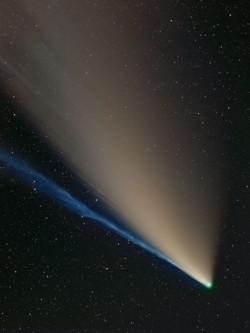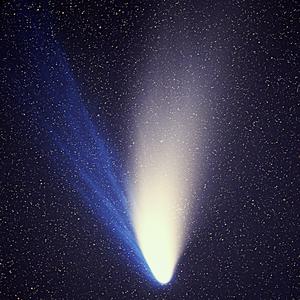Glossary term: 彗尾
Description: 当彗星靠近太阳时,太阳辐射会加热彗星表面。表面的冰变成气体("升华"),同时带走岩石和尘埃物质。由此产生的混合物在彗核周围形成一团云,这就是彗发。一般来说,彗星会有两条尾巴:喷射出的尘埃粒子形成彗尾,彗尾呈典型的弯曲状。它由从表面释放出来的尘埃粒子组成,这些尘埃粒子沿着彗星的轨道绕太阳运行。尘埃尾的长度可达数百万公里或更长。它们反射太阳光,如果条件合适,肉眼能观测到的彗星大部分都是由它们的白色漫射形状组成的。
相当一部分气体被太阳风--太阳发出的带电粒子--吹走并电离。这些离子形成了彗星的离子尾,通常呈蓝色。离子尾总是直指太阳。如果彗星本身正在远离太阳,离子尾就会在彗星之前。
Related Terms:
See this term in other languages
Term and definition status: The original definition of this term in English have been approved by a research astronomer and a teacher The translation of this term and its definition is still awaiting approval
The OAE Multilingual Glossary is a project of the IAU Office of Astronomy for Education (OAE) in collaboration with the IAU Office of Astronomy Outreach (OAO). The terms and definitions were chosen, written and reviewed by a collective effort from the OAE, the OAE Centers and Nodes, the OAE National Astronomy Education Coordinators (NAECs) and other volunteers. You can find a full list of credits here. All glossary terms and their definitions are released under a Creative Commons CC BY-4.0 license and should be credited to "IAU OAE".
If you notice a factual or translation error in this glossary term or definition then please get in touch.
Related Media
彗星 C/2020F3 (Neowise),有分开的尘埃尾和离子气体尾,以及发出绿色光芒的彗发,作者 Dietmar Gutermuth,德国
Credit: Dietmar Gutermuth/IAU OAE
License: CC-BY-4.0 Creative Commons 署名 4.0 国际 (CC BY 4.0) icons
你好,彗星,我们跳舞好吗?作者罗伯特·巴尔萨,斯洛伐克
Credit: 罗伯特·巴尔萨/国际天文学联合会教育办公室
License: CC-BY-4.0 Creative Commons 署名 4.0 国际 (CC BY 4.0) icons
海尔-波普彗星
Credit: E.Kolmhofer, H. Raab; Johannes Kepler Observatory, Linz, Austria credit link
License: CC-BY-SA-3.0 Creative Commons Attribution-ShareAlike 3.0 Unported icons











